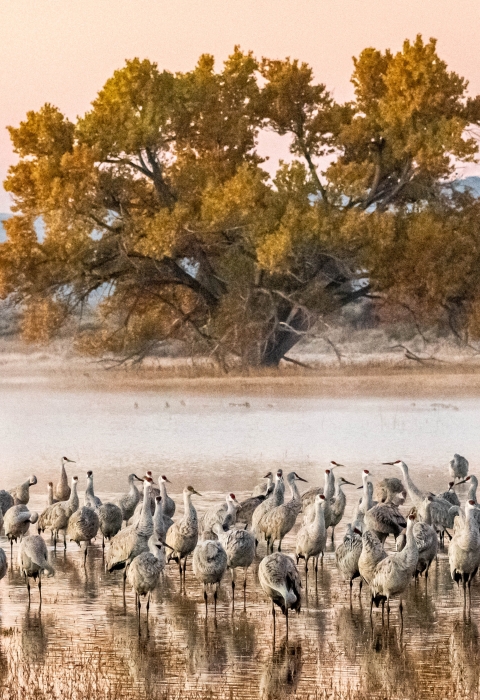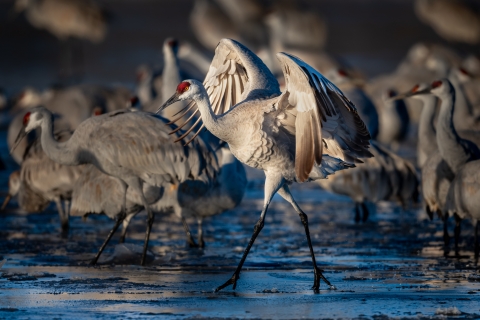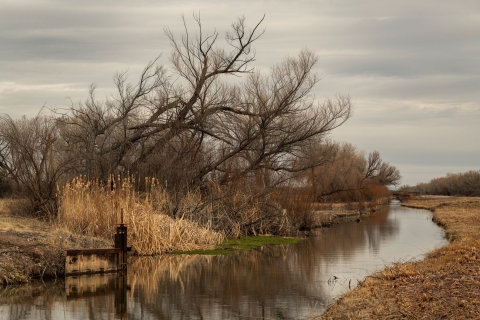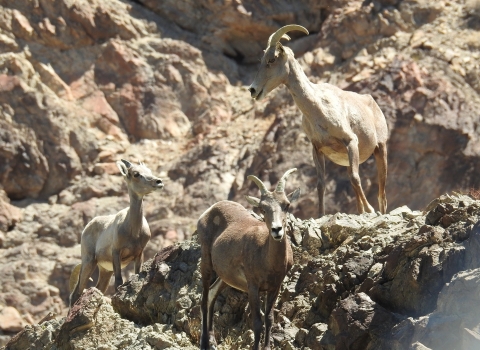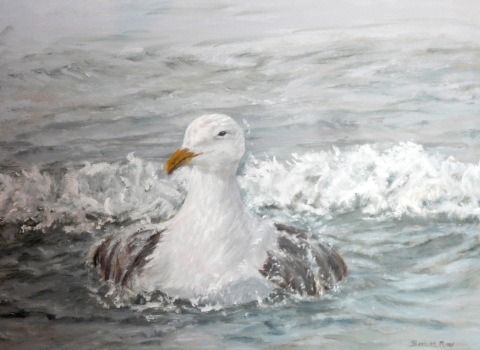The Wetland Roost
Each December morning, hundreds of spectators travel to witness the wonder of winter bird migration in the heart of New Mexico’s desert. Near the northern edge of Bosque del Apache National Wildlife Refuge sits a beautiful area known as the “Wetland Roost.”. This is where many of those travelers begin their Bosque del Apache experience. You may recognize the scene of a thousand sandhill cranes peacefully standing over shimmering water in front of hazy blue mountains. During sunrise a few hundred snow geese will lift off noisily in the cold morning air.
However, this iconic experience has been missing at this location over the past two years. There has been no water in the Wetland Roost, and thus no flocks of cranes spending the night there. Take a drive to the refuge these past two winters and you will have noticed a parking lot for the Wetland Roost facing a dry desert expanse. This has been confusing and disappointing for all who love the refuge. Even though there are many other seasonal wetlands to enjoy, many visitors wonder if the condition of the Wetland Roost represents the whole refuge.
Water-wise Decisions
Why has the Wetland Roost not been filled since autumn of 2019? In New Mexico, water availability has changed dramatically. With most of the state facing severe drought conditions and predictions of an even drier future, we must recognize that practices that were sustainable in the past are no longer sustainable now. Every land manager must adapt to be water-efficient and meticulous with how to best use this precious resource. At Bosque del Apache, that means that refuge biologists and management have also changed how water is used on the land.
Limited water at Bosque del Apache translates to prioritizing the filling of seasonal wetlands which have high amounts of migratory bird food. This has left the Wetland Roost dry as refuge staff waited for the people, tools, and time to revitalize this beloved wetland and improve its water efficiency.
Adapting the Landscape
Every challenge can be seen as an opportunity, and the temporary pause of the Wetland Roost is no exception. The Wetland Roost is a prime candidate for water-efficient restructuring. Refuge manager Deb Williams is picturing this fall as a time to continue reshaping the landscape for drought efficiency.
Watch Deb Williams describe the upcoming changes to the Wetland Roost landscape.
Soon the Wetland Roost will be full of movement. Refuge staff will work together using tractors and construction equipment to reshape the land. A bulldozer will mold the back of the area so that the water will have a western barrier – preventing water from seeping into the dry desert bajada. A scraper will level the ground so water will fill evenly in the future – optimizing every drop to provide that expanse of water the cranes enjoy. An excavator will repair the ditch that runs from the well to the wetland, improving the flow of water from its future source. All these changes will help make this unit more water efficient.
Adapting Us
Water challenges are unlikely to lessen in coming years. They impact all of us, not just here on the refuge. Water is a shared resource among many users across multiple states. This complicates management and conservation. From Montana down to New Mexico, the rancher, farmer, national wildlife refuge national wildlife refuge
A national wildlife refuge is typically a contiguous area of land and water managed by the U.S. Fish and Wildlife Service for the conservation and, where appropriate, restoration of fish, wildlife and plant resources and their habitats for the benefit of present and future generations of Americans.
Learn more about national wildlife refuge , state park, and household all may have different priorities, but we all need to work together to conserve, enhance, and protect our shared natural resources. We need to think of conservation not just as something done by parks and wild spaces, but as something that we all do together no matter where we are, and no matter who we are. A healthy river ecosystem supports a healthy valley for all of us.
Here at Bosque del Apache, volunteers and staff will continue to respond to changes to natural resources, and we will continue to prepare for our shared future as part of the community of the Rio Grande Valley.
